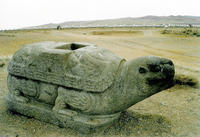You are in: Asia -> Mongolia -> Orkhon Valley Cultur... , and traditional search or Image Gallery will yield results of this site only
Orkhon Valley Cultural Landscape
| Site number: | 1081 |
|
| Type of site: | Cultural | |
| Date: | 13-14th century | |
| Date of Inscription: | 2004 | |
| Location: | Asia, Mongolia, Orkhon-Kharkorin Region | |
Up to 75 images are shown here. Click on each for more details or on Image Gallery for more images.
| Description: | Wide areas of pastureland on both banks of the Orkhon River make up the 121,967-ha of Orkhon Valley Cultural Landscape, which boasts copious amounts of archaeological remains that date back to the 6th century. In addition, the site also includes Kharkhorum - the capital of Chingis (Genghis) Khan’s immense Empire in the 13th and 14th century. The site’s remains when looked at as a whole reveal the symbiotic links between the nomadic, pastoral societies and their governmental and religious centres, as well as the significance of the Orkhon valley in the central Asia’s history. Mongolian nomadic pastoralists still graze the grassland. --WHMNet paraphrase from the description at WHC Site, where additional information is available. | |
| Orkhon Valley Cultural Landscape sprawls along the banks of the Orkhon River in Central Mongolia, some 360 km west from the capital Ulaanbaatar. It was inscribed by UNESCO in the World Heritage List as representing evolution of nomadic pastoral traditions spanning more than two millennia. For many centuries, the Orkhon Valley was viewed as the seat of the imperial power of the steppes. The first evidence comes from a stone stele with runic inscriptions, which was erected in the valley by Bilge Khan, an 8th-century ruler of the Göktürk Empire. Some 25 miles to the north of the stele, in the shadow of the sacred forest-mountain Ötüken, was his Ördü, or nomadic capital. During the Qidan domination of the valley, the stele was reinscribed in three languages, so as to record the deeds of a Qidan potentate. Mountains were considered sacred in Tengriism as an axis mundi, but Ötüken was especially sacred because the ancestor spirits of the khagans and beys resided here. Moreover, a force called qut was believed to emanate from this mountain, granting the khagan the divine right to rule the Turkic tribes. Whoever controlled this valley was considered heavenly appointed leader of the Turks and could rally the tribes. Thus control of the Orkhon Valley was of the utmost strategic importance for every Turkic state. Historically every Turkic capital (Ördü) was located here for this exact reason. --Wikipedia. Text is available under the Creative Commons Attribution-ShareAlike License. | ||
| Rights of Image: | www.World-Heritage-Tour.org | |
| Source: | http://whc.unesco.org/en/list/1081 | |
| Reference: | 1. UNESCO World Heritage Center, Site Page. | |














